Comprehensive Physical Properties and Exploration Potential of the Permian Igneous Rocks in the Southwestern Sichuan Basin
Abstract
:1. Introduction
2. Geology
3. Rock Sample Collection and Physical Property Tests
3.1. Volcanic Outcrop Rock Sample Collection
3.2. Principles and Methods of Testing the Physical Properties of the Rock Samples
4. Geologic Features
4.1. Petrological Characteristics
4.2. Physical Characteristics of Reservoirs
4.3. Mineral Composition of Igneous Rocks
4.4. Basalt Reservoir Characteristics
5. Gravity, Magnetic, and Electrical Characteristics and Physical Properties of Igneous Rocks
5.1. Density and Magnetic Susceptibility of Igneous Rocks
5.2. Complex Resistivity Characteristics of Igneous Rocks
5.2.1. Complex Resistivity of Igneous Rocks
5.2.2. Inversion of the Complex Resistivity Parameters of the Volcanic Rocks
6. Exploration Potential of Permian Igneous Oil and Gas Reservoirs in Southwestern Sichuan
6.1. Multi-Parameter Comprehensive Analysis of the Igneous Rocks’ Physical Properties
6.1.1. Comprehensive Physical Characteristics of the Igneous Rocks, including Density, Magnetic Susceptibility, and Resistivity
6.1.2. Multi-Parameter Relationship Model of Physical Properties
6.2. Exploration Potential of Permian Igneous Rocks in Southwestern Sichuan
7. Conclusions
- (1)
- The porosity and permeability of the igneous rocks in southwestern Sichuan indicate that the physical properties of these reservoirs are generally poor, and there are basically no effective pores and fractures in the basalt thin sections and electron microscope images. They are mainly ultra-low porosity and ultra-low permeability rocks, and the intergranular micropores were observed in the scanning electron microscope images. Although the primary pores are undeveloped, the microfractures connect the unconnected pores, which greatly improves the physical properties of these reservoirs.
- (2)
- The density, magnetic susceptibility, resistivity, and polarizability measurements show that the igneous rocks in southwestern Sichuan have a high density and high magnetic susceptibility. In particular, the strong magnetism of the basalts is more obvious than those of the other lithologies. The resistivity and polarizability of the igneous rocks vary widely, even within the same lithology, which indicates that the conductive mechanism of the igneous rocks is complex. Overall, the basalt in southwestern Sichuan is characterized by high density, high resistivity, and strong magnetism; the tuff is characterized by medium-high density, medium-high resistivity, and weak magnetism; and the volcanic breccia is characterized by a high density, medium-low resistivity, and strong magnetism. The comprehensive resistivity parameter, i.e., the polarizability, can be used as an important index parameter for determining the lithology and lithofacies of the igneous rocks and for reservoir evaluation.
- (3)
- The three-dimensional plot of the resistivity, density, and magnetic susceptibility, and the three-dimensional plot of the polarizability, density, and magnetic susceptibility show that the distribution characteristics of the physical parameters of the igneous rocks with different lithologies are distinct, and these plots can be used as an important basis for identifying igneous rocks with different lithologies. The relationships between the physical parameters and reservoir parameters established for the study area reflect the porosity distribution range of the different lithologies and provide effective parameters for igneous reservoir evaluation.
- (4)
- The comprehensive physical characteristics of the Permian igneous rocks in southwestern Sichuan are prominent. They provide a physical basis for gravity, magnetic, and electrical exploration, showing that these igneous rocks have a good natural gas exploration potential. Because igneous reservoirs are more complex than conventional sedimentary reservoirs and there are many problems to be solved regarding igneous rock facies, lithologies, and reservoir physical properties, many geological and geophysical techniques still need to be improved for use in igneous oil and gas reservoir identification and reservoir prediction and evaluation. This study provides a physical basis and technical support for gravity-magnetic-electrical exploration of the igneous oil and gas reservoirs in the Sichuan Basin. However, the research on the physical properties of these igneous rocks is still insufficient, and other specimens need to be collected and analyzed, such as the Jianyang-Santai area in the central and western parts of the basin, to further deepen our understanding of the gravity, magnetic, and electrical physical properties of the igneous rocks in this region.
Author Contributions
Funding
Data Availability Statement
Acknowledgments
Conflicts of Interest
References
- Chung, S.L.; Jahn, B.M. Plume-lithosphere interaction in generation of the Emeishan flood basalts at the Permian-Triassic boundary. Geology 1995, 23, 889. [Google Scholar] [CrossRef]
- Wignall, P.B. Large igneous provinces and mass extinctions. Earth-Sci. Rev. 2001, 53, 1. [Google Scholar] [CrossRef]
- Xu, Y.; Chung, S.L.; Jahn, B.M.; Wu, G. Petrologic and geochemical constraints on the petrogenesis of Permian–Triassic Emeishan flood basalts in southwestern China. Lithos 2001, 58, 145. [Google Scholar] [CrossRef]
- Thompson, G.M.; Ali, J.R.; Song, X.; Jolley, D.W. Emeishan Basalts, SW China: Reappraisal of the formation’s type area stratigraphy and a discussion of its significance as a large igneous province. J. Eological Soc. 2001, 158, 593. [Google Scholar] [CrossRef] [Green Version]
- Luo, J.; Wang, F.; He, S.; He, Z.; Huang, Y.; Zhang, D.; Zhu, Y.; Sun, Z.; Luo, T. Characteristics of Vein-Forming Fluids in the Sinian Dengying Formation Reservoir and Its Relationship with the Hydrocarbon Accumulation Process in the Southwest and Southeast of the Sichuan Basin. Minerals 2022, 12, 443. [Google Scholar] [CrossRef]
- Ma, X.; Yang, Y.; Zhang, J.; Xie, J. A major discovery in Permian volcanic rock gas reservoir exploration in the Sichuan Basin and its implications. Nat. Gas Ind. 2019, 39, 1. [Google Scholar] [CrossRef]
- Xie, J.; Ya, L.; Yang, Y.; Zhang, B.; Liu, R.; He, Q.; Wang, W.; Wang, Y. Main controlling factors and natural gas exploration potential of Permian scale volcanoclastic reservoirs in the western Sichuan Basin. Nat. Gas Ind. 2021, 41, 48. [Google Scholar] [CrossRef]
- Ma, X.; Li, G.; Ying, D.; Zhagn, B.; Li, Y.; Dai, X.; Fan, Y.; Zeng, Y. Distribution and gas-bearing properties of Permian igneous rocks in Sichuan Basin, SW China. Pet. Explor. Dev. 2019, 46, 216. [Google Scholar] [CrossRef]
- Liu, R.; Luo, B.; Li, Y.; Qiu, N.; Wang, W.; Zhang, Y.; He, Q.; Pei, S. Relationship between Permian volcanic rocks distribution and karst paleogeomorphology of Maokou Formation and its significance for petroleum exploration in western Sichuan Basin, SW China. Pet. Explor. Dev. 2021, 48, 575. [Google Scholar] [CrossRef]
- Zhou, D.; Dong, Q. Characteristics and formation of igneous oil and gas reservoirs. Lithol. Reserv. 2010, 22, 80. [Google Scholar]
- Liu, P.; Chen, K.; He, Q.; Peng, W.; Zebin, L.; Liu, Z. Discussion on fracture eruption mode of Permian volcanic rocks in Sichuan Basin. Oil Geophys. Prospect. 2021, 56, 389. [Google Scholar] [CrossRef]
- Wu, Y.; Xie, B.; Wu, L.; Lai, Q.; Zhao, R. Logging based lithology identification of Permian mafic volcanic rocks in the Sichuan Basin: A case study from the Well Yongtan 1. Nat. Gas Ind. 2019, 39, 43. [Google Scholar] [CrossRef]
- Xia, M.; Wen, L.; Li, Y.; Luo, B.; He, K.; Liu, R.; Qiu, Y.; He, Q.; Chen, K. Permian volcanic eruption cycle, environment and model in the Jianyang area of the Sichuan Basin. Nat. Gas Ind. 2020, 40, 43. [Google Scholar] [CrossRef]
- Liu, X.; Xia, M.; Wu, Y.; He, Q.; Li, Y.; Liu, R. Characteristics of Permian volcaniclastic lava reservoirs in Yongtan 1 well, Sichuan Basin. Nat. Gas Explor. Dev. 2019, 42, 28. [Google Scholar] [CrossRef]
- Wen, L.; Li, Y.; Yi, H.; Liu, X.; Zhang, B.; Qiu, Y.; Zhou, G.; Zhang, X. Lithofacies and reservoir characteristics of Permian volcanic rocks in the Sichuan Basin. Nat. Gas Ind. 2019, 39, 17. [Google Scholar] [CrossRef]
- Lu, J.; Zuo, Z.; Shi, Z.; Dong, X.; Wu, Q.; Song, X. Characteristics of Permian volcanism in the western Sichuan Basin and its natural gas exploration potential. Nat. Gas Ind. 2019, 39, 46. [Google Scholar] [CrossRef]
- He, Z.; Hu, Z.; Wang, Z.; Zhao, Y.; Shen, Y.; Liu, X. Time-frequency electromagnetic (TFEM) technique: Step-by-step constraint inversion based on artificial fish swarm algorithm. Oil Geophys. Prospect. 2020, 55, 898. [Google Scholar] [CrossRef]
- Zhang, C.; Liu, X.; He, L.; He, W.; Zhou, Y.; Zhu, Y.; Cui, Z.; Kuang, X. A study of exploration organic rich shales using Time-Frequency Electromagnetic Method (TFEM). Chin. J. Geophys. 2013, 56, 3173. [Google Scholar] [CrossRef]
- Xu, C.; Xu, Z.; Yang, Z.; Zhang, K. Application effect of complex resistivity (CR) method in detecting oil and gas reservoirs. Oil Geophys. Prospect. 2004, 39, 31. [Google Scholar]
- Zhang, B. Deep Fault System in Southwest Sichuan and Its Control on Permian Volcanic Rocks; China University of Geosciences: Beijing, China, 2020. [Google Scholar]
- Yang, H.; Wen, B.; Dai, X.; Wang, L.; Zhu, R.; Hou, L.; Mao, Z.; Zhang, L.; Song, X. Comprehensive predication of hydrocarbon deposits in volcanic rock by gravity, magnetic, electrical and seismic data and its application. Chin. J. Geophys. 2011, 54, 286. [Google Scholar] [CrossRef]
- Xiang, K.; Yan, l.; Hu, H.; Hui, Y.; Wen, B. Characteristics and modeling of gravity, magnetism and electricity physical properties of Precambrian in Sichuan Basin. Oil Geophys. Prospect. 2020, 55, 1160. [Google Scholar] [CrossRef]
- Bian, B.; Wang, X.; Gu, S.; Li, Z.; Nueraili, Z. Application of “Five-dimensional Integration” Comprehensive Geophysical Prospecting Technology of Magnetoelectric Seismic Wells in Carboniferous Volcanic Rock Identification in Dabasong Uplift. In Proceedings of the CPS/SEG Beijing 2018 International Geophysical Conference and Exhibition, Beijing, China, 24–27 April 2018; p. 1267. [Google Scholar]
- Suo, X.; Zhang, S.; Chen, D. Identification of the Carboniferous Volcanic Lithology with Gravitational-Magnetic-Electric Abnormal Information Pattern—An example from eastern Luliang uplift area in Junggar basin. Xinjiang Pet. Geol. 2011, 32, 318. [Google Scholar]
- Xia, Y.; Li, Y.; Cai, Y.; Huang, Y. Application of “Five-in-One” Volcanic Rock Identification Technology of Gravity, Magnetism, Electric, Well-log, Seismic in Carboniferous Natural Gas Exploration in Dinan Uplift. Xinjiang Geol. 2021, 39, 448. [Google Scholar]
- Zhang, S.; Zhang, P.; Tian, Z.; Yang, Z.; Cui, Z. Description of Deep Volcanic Reservoir in Junggar Basin by Magnetoelectric-Seismic Multi-information Combination. In Proceedings of the CPS/SEG Beijing 2018 International Geophysical Conference & Exposition Electronic papers, Beijing, China, 24–27 April 2018; p. 1282. [Google Scholar]
- Guo, H.; Ye, W.; Zenghui, F.; Ming, X.; Yulin, H.; Mingyi, L.; Yi, W. Application of non-seismic exploration technologies to Sichuan Basin. Nat. Gas Explor. Dev. 2019, 42, 58. [Google Scholar] [CrossRef]
- Pelton, W.H.; Ward, S.H.; Hallof, P.G.; Sill, W.R.; Nelson, P.H. Mineral discrimination and removal of inductive coupling with multi-frequency IP. Geophysics 1978, 43, 588. [Google Scholar] [CrossRef]
- Dias, C.A. Developments in a model to describe low-frequency electrical polarization of rocks. Geophysics 2000, 65, 437. [Google Scholar] [CrossRef]
- Luo, Y.; Zhang, G. Principle of Frequency Domain IP Method; Geological Publishing House: Beijing, China, 1988. [Google Scholar]
- Xiang, K.; Hu, W.; Yan, l.; Zhang, C.; He, W.; Tang, X.; Liu, X. Dispersion characteristics of shale complex resistivity in Sichuan and Guizhou areas. Oil Geophys. Prospect. 2014, 49, 1013. [Google Scholar] [CrossRef]
- Yang, Y.; Yang, Y.; Wen, L.; Zhang, X.; Chen, C.; Chen, K.; Zhang, Y.; Di, G.; Wang, H.; Xie, C. New exploration progress and prospect of Middle Permian natural gas in the Sichuan Basin. Nat. Gas Ind. 2020, 40, 10. [Google Scholar] [CrossRef]
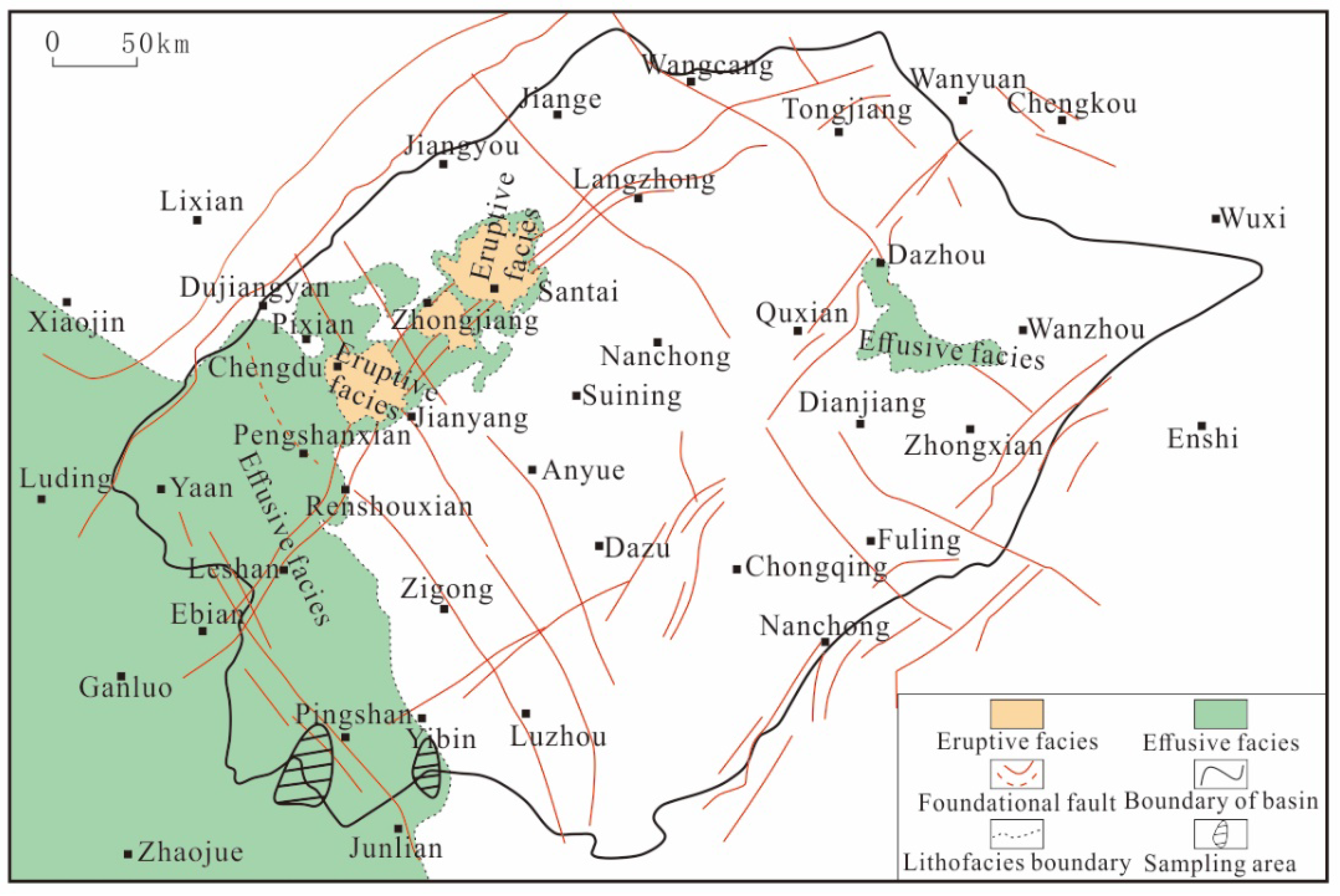
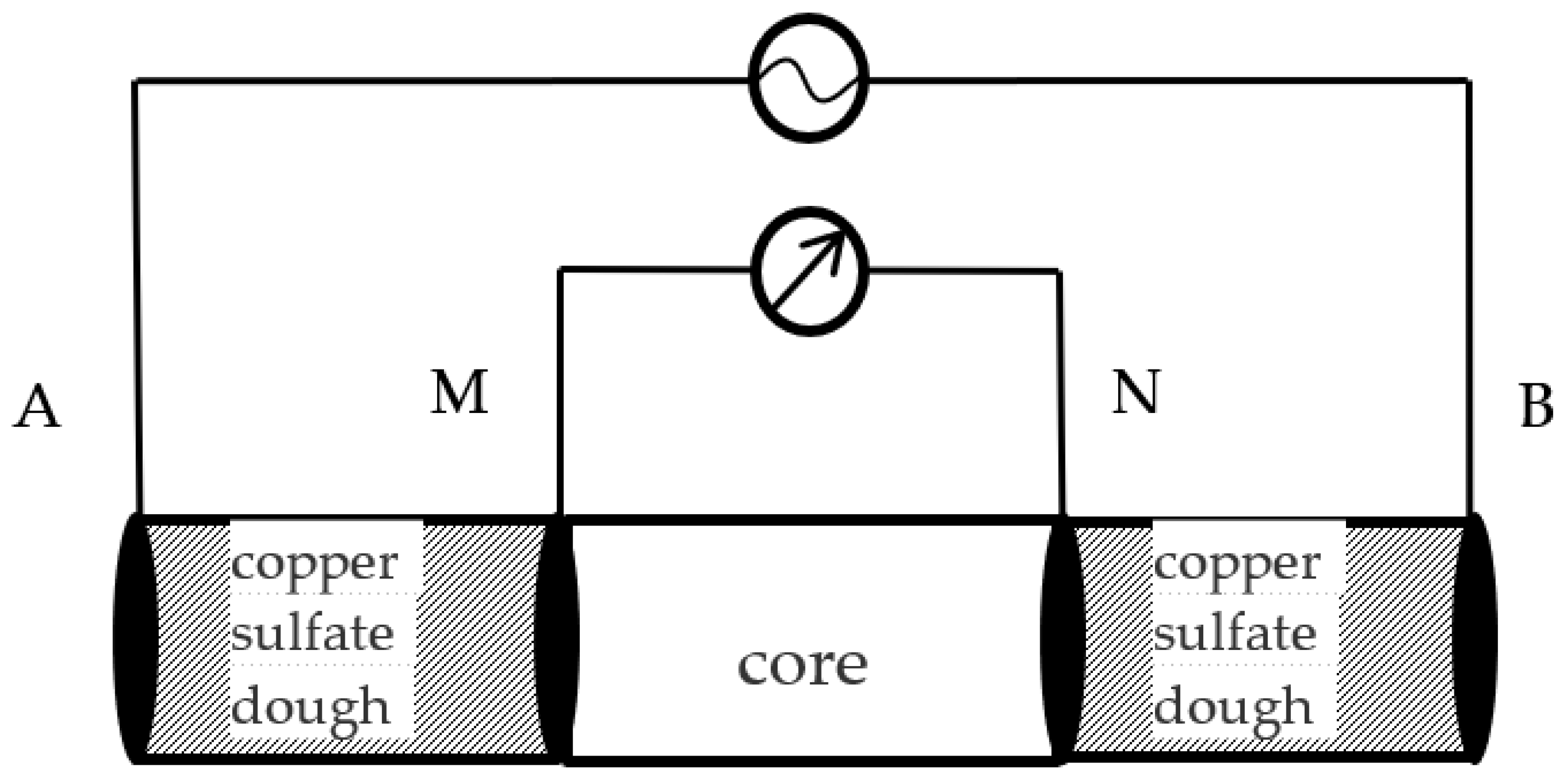
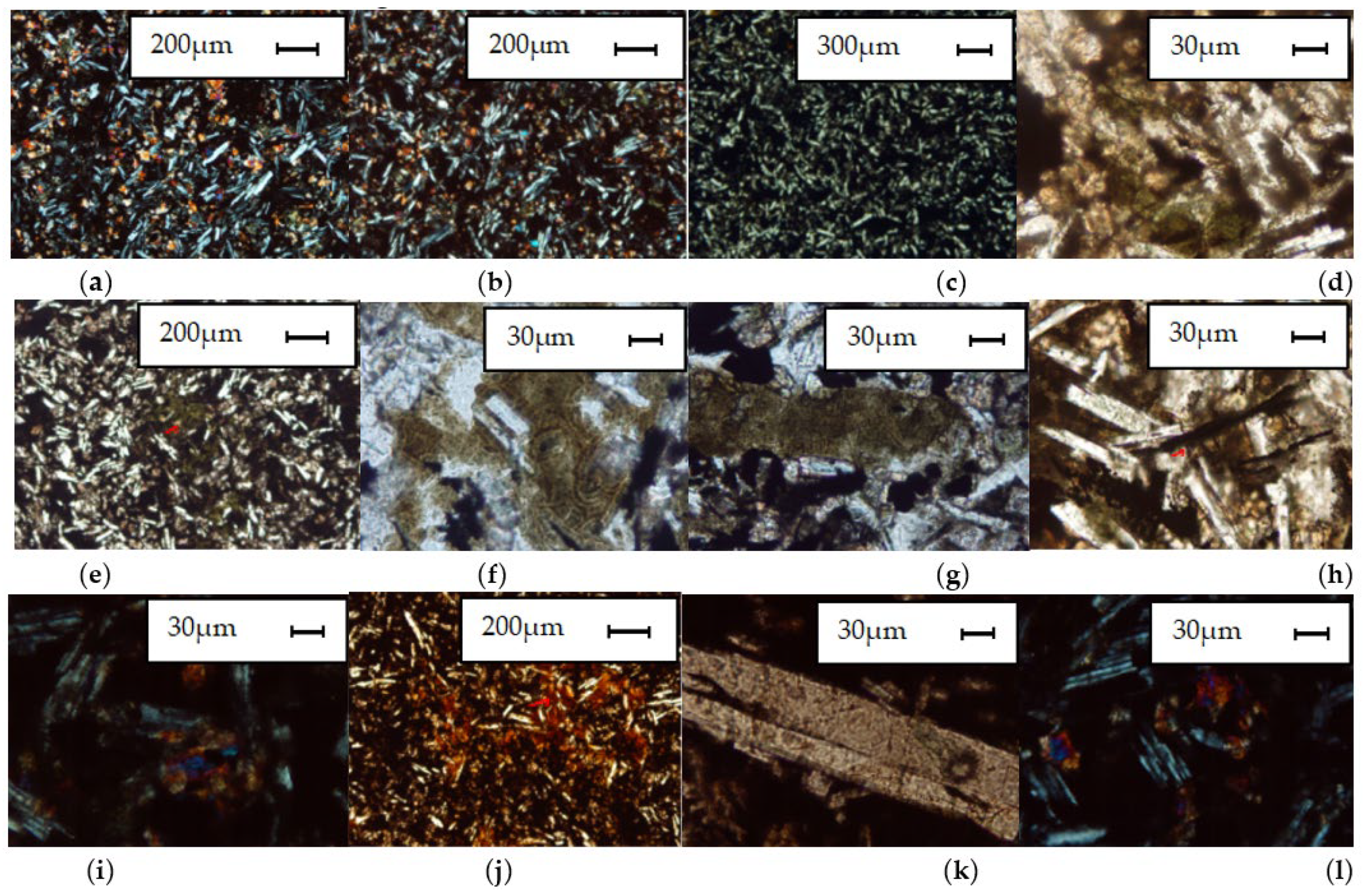
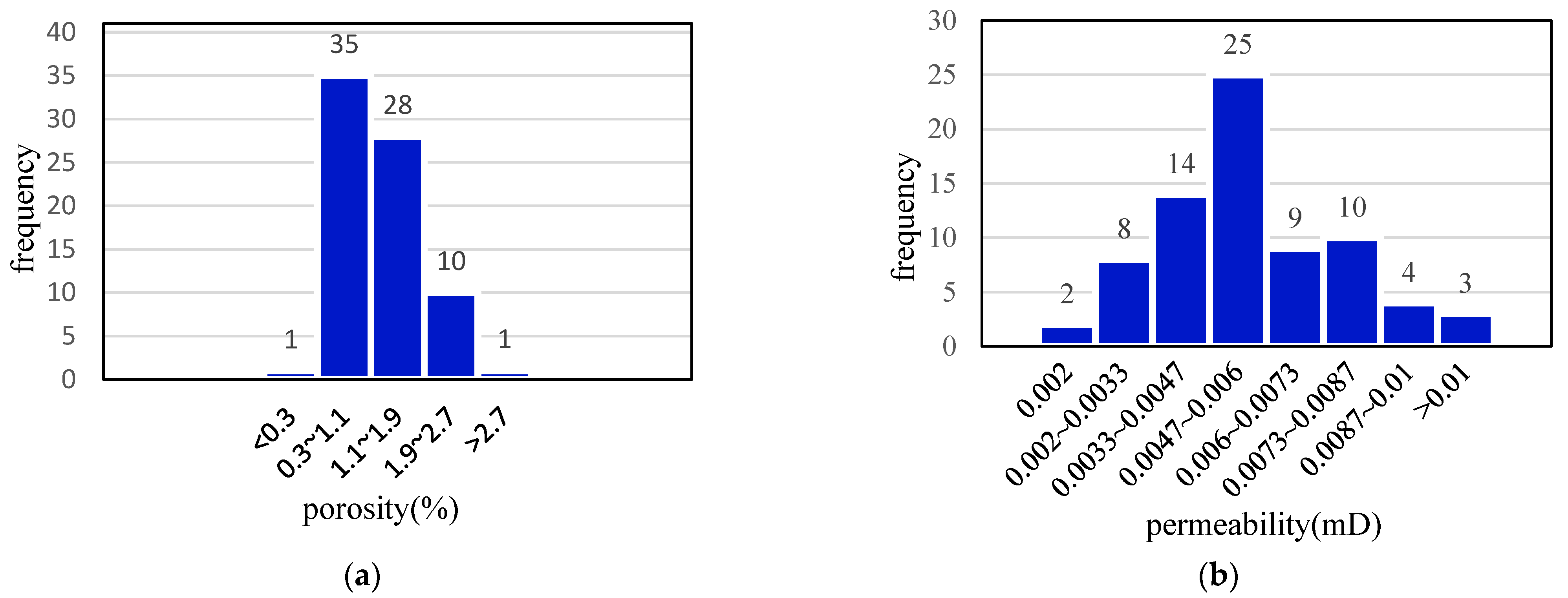
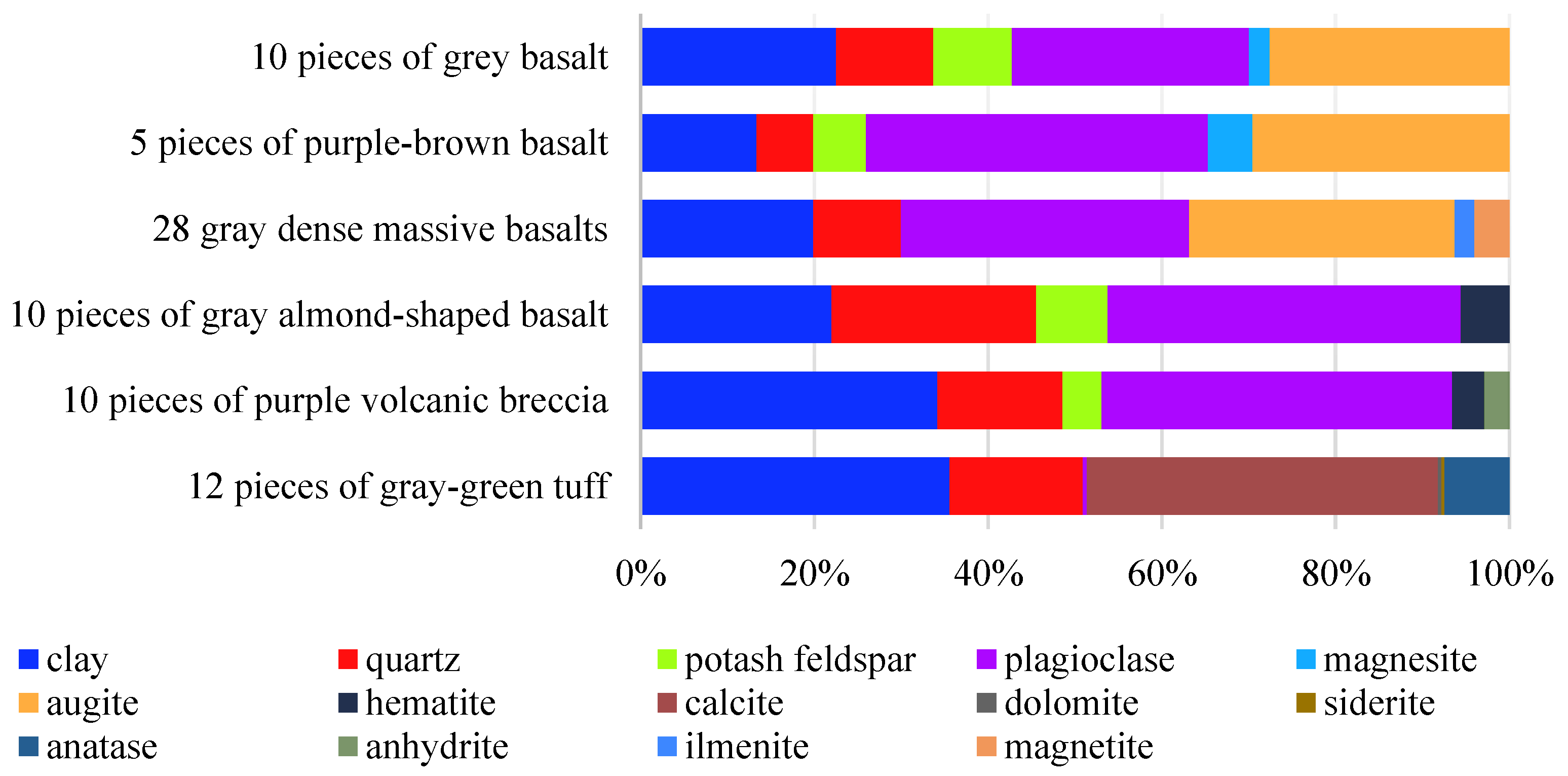
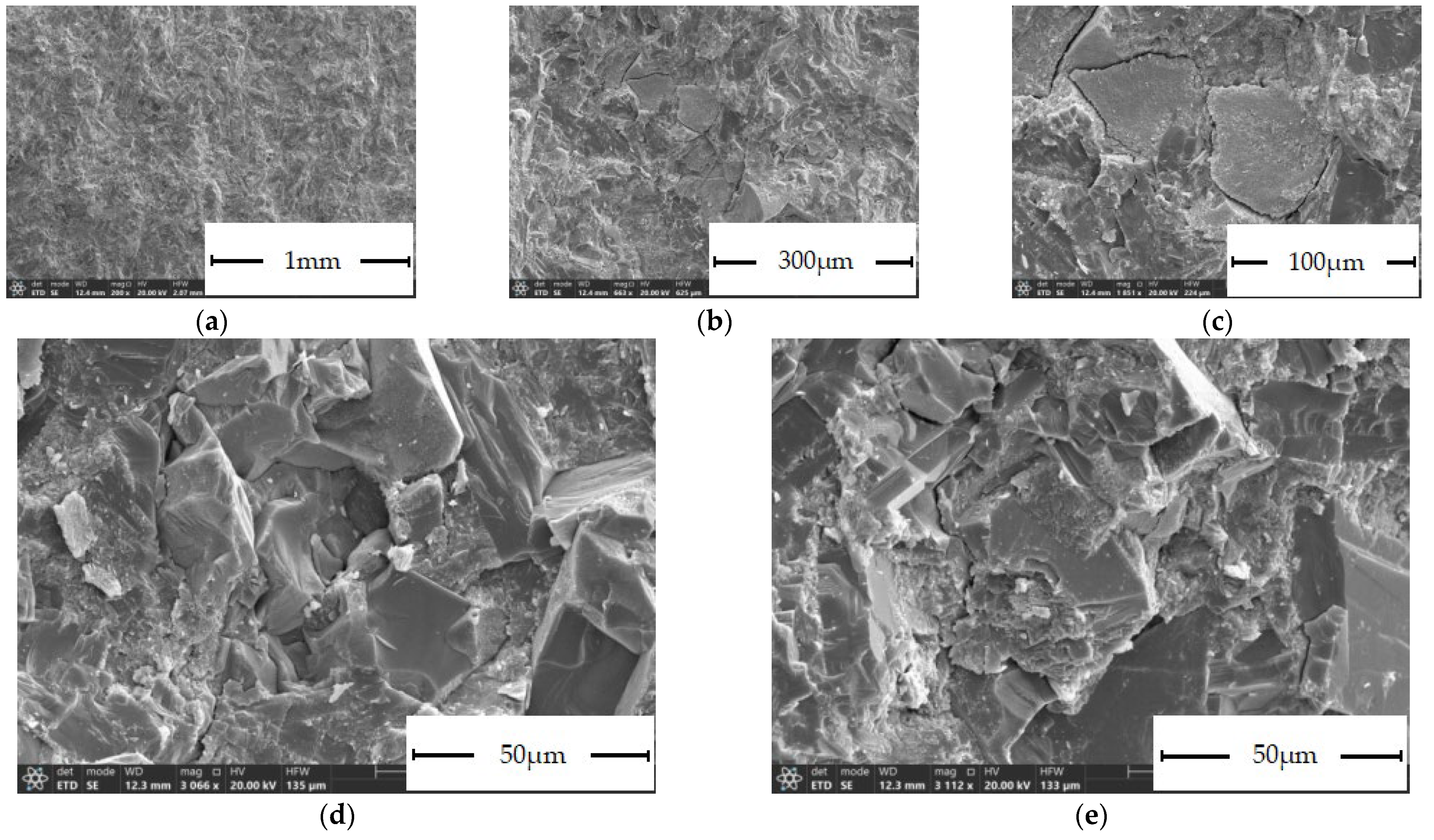
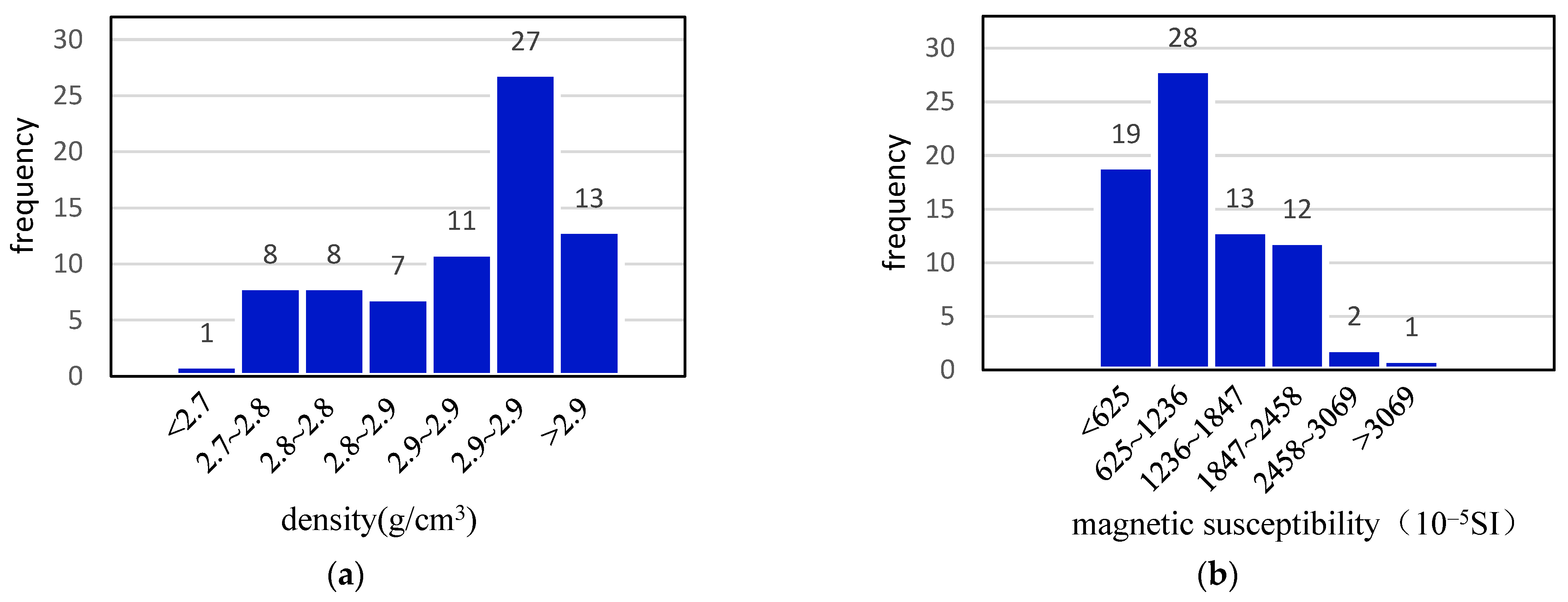
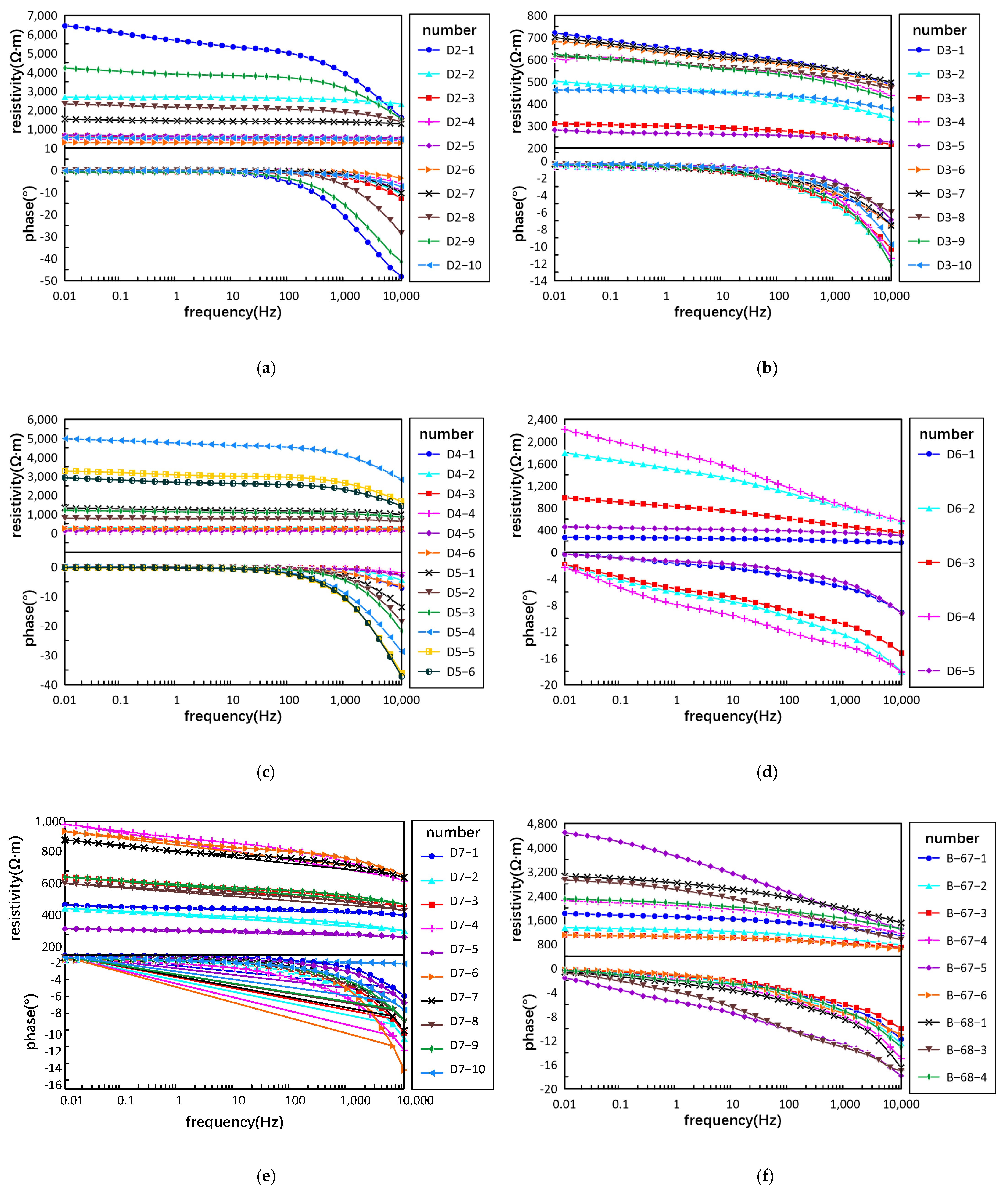
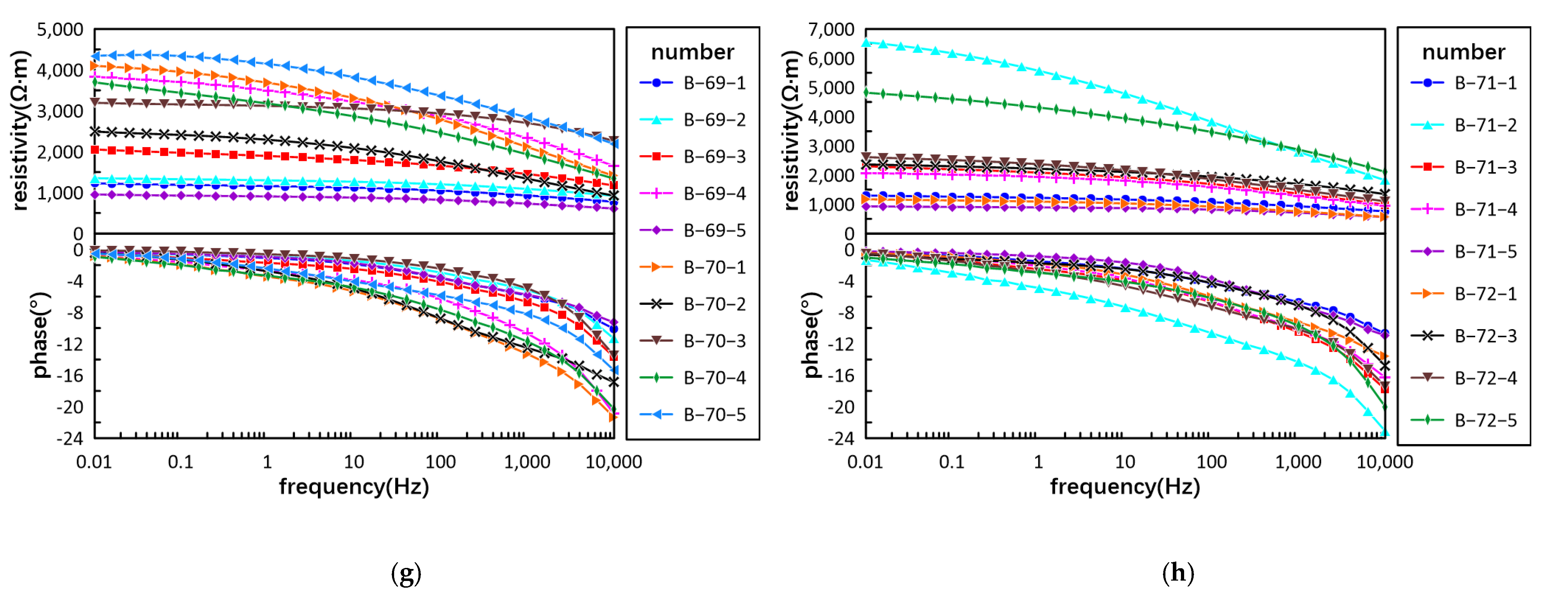
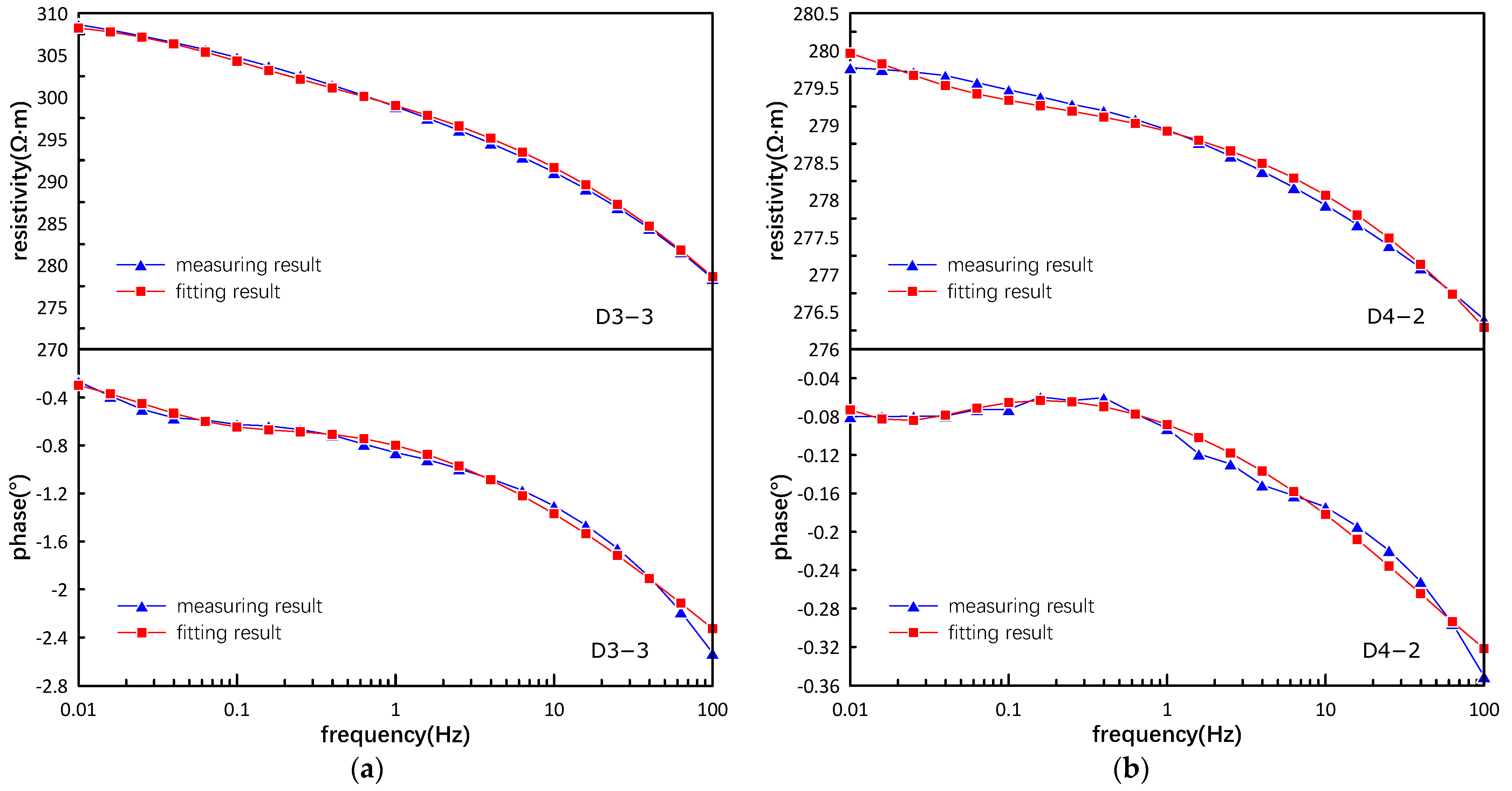
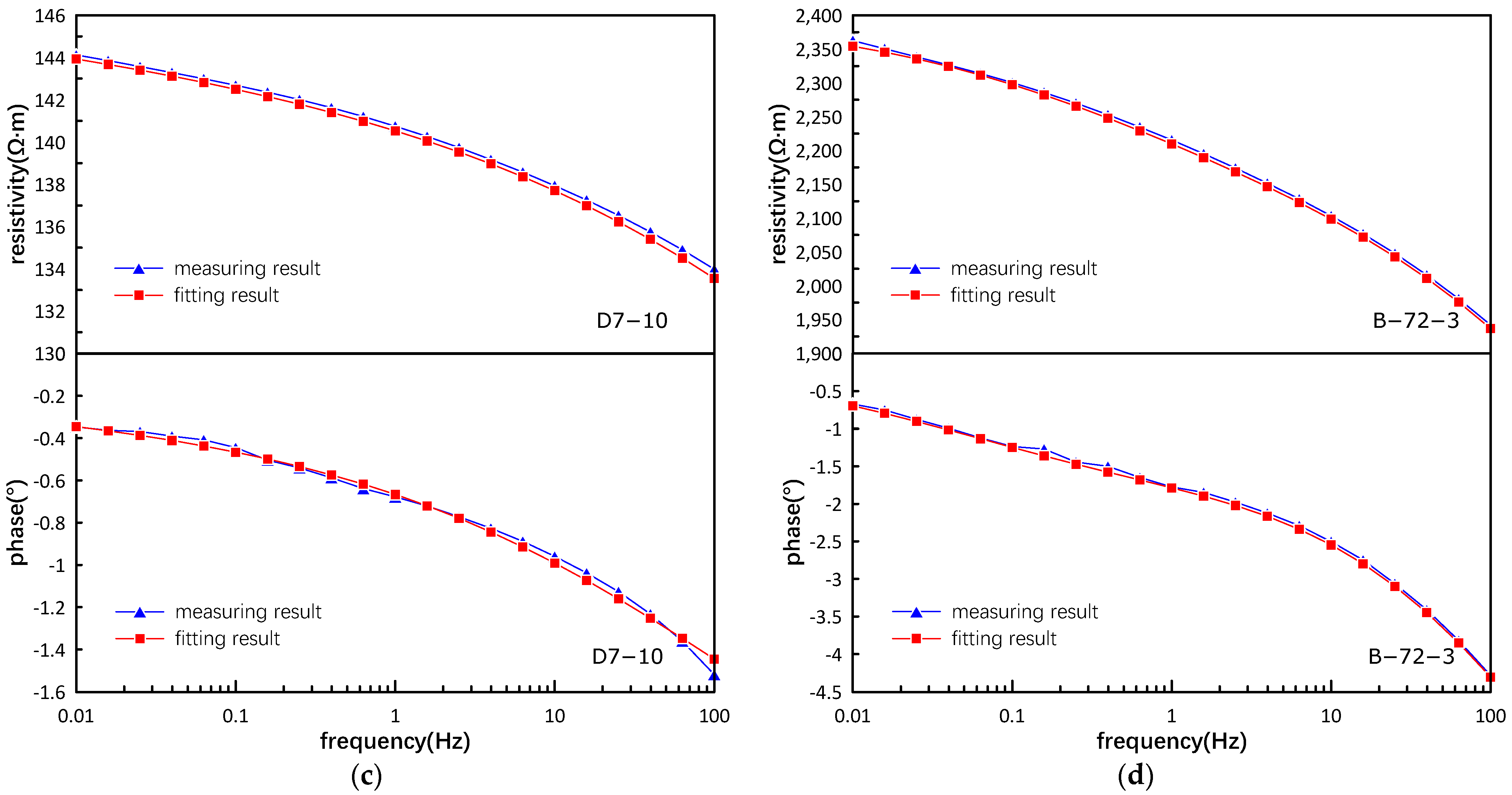
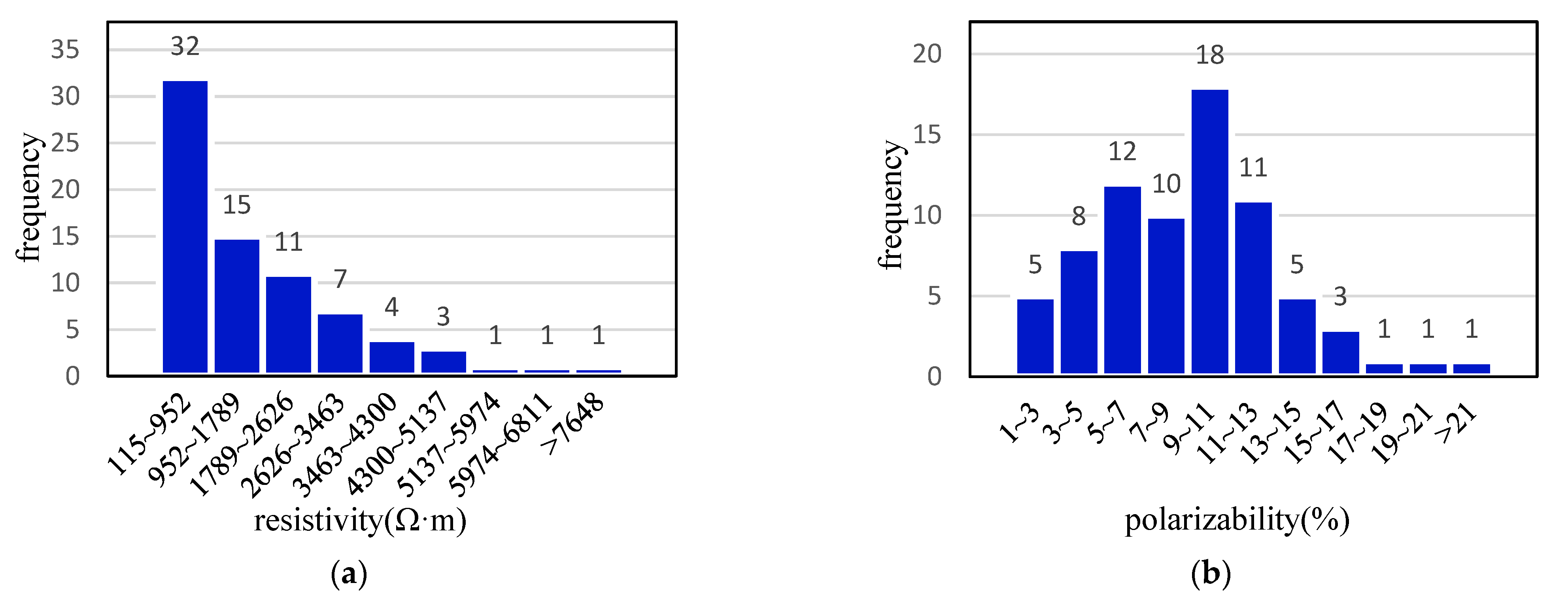

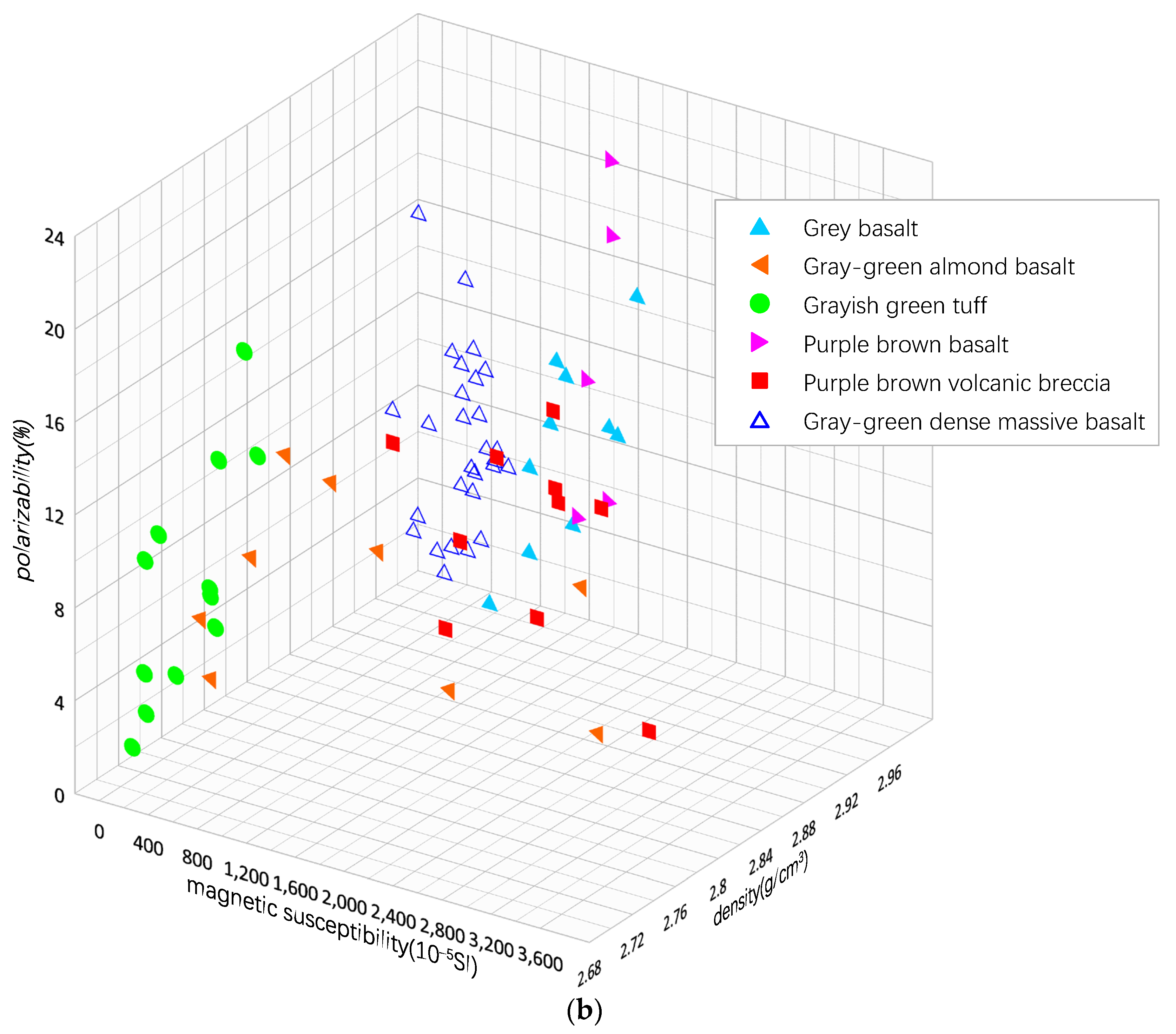
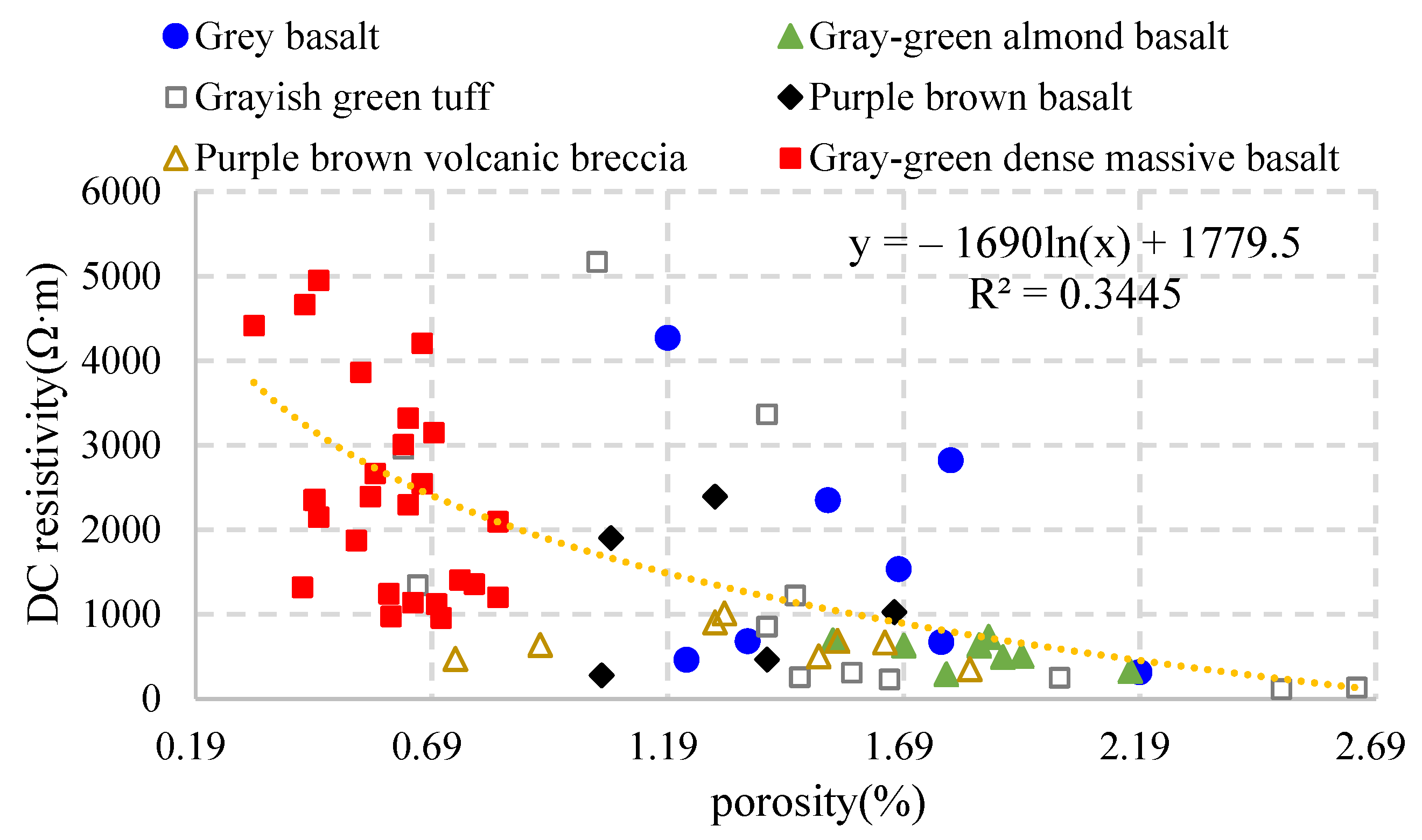

| Sample Number | Area | Age | Rock Type | Quantity |
|---|---|---|---|---|
| D2-1 to D2-10 | Ya’an-Yibin fault zone to Yibin | P2β | gray basalt | 10 |
| D3-1 to D3-10 | Ya’an-Yibin fault zone to Yibin | P2β | gray-green almond basalt | 10 |
| D4-1 to D4-6 | Ya’an-Yibin fault zone to Yibin | P2β | grayish green tuff | 6 |
| D5-1 to D5-6 | Ya’an-Yibin fault zone to Yibin | P2β | grayish green tuff | 6 |
| D6-1 to D6-5 | Ya’an-Yibin fault zone to Yibin | P2β | purple-brown basalt | 5 |
| D7-1 to D7-10 | Ya’an-Yibin fault zone to Yibin | P2β | purple-brown volcanic breccia | 10 |
| B-67-1 to B-67-6 | Yibin Gongxian County | P2β | gray-green dense massive basalt | 6 |
| B-68-1 to B-68-3 | Yibin Gongxian County | P2β | gray-green dense massive basalt | 3 |
| B-69-1 to B-69-5 | Yibin Gongxian County | P2β | gray-green dense massive basalt | 5 |
| B-70-1 to B-70-5 | Yibin Gongxian County | P2β | gray-green dense massive basalt | 5 |
| B-71-1 to B-71-5 | Yibin Gongxian County | P2β | gray-green dense massive basalt | 5 |
| B-72-1 to B-72-4 | Yibin Gongxian County | P2β | gray-green dense massive basalt | 4 |
| Area * | Rock Type | Quantity (Blocks) | Porosity Range (%) | Average Porosity (%) | Permeability Range (mD) | Average Permeability (mD) |
|---|---|---|---|---|---|---|
| D | gray basalt | 10 | 1.03–2.19 | 1.568 | 0.003–2.037 | 0.2074 |
| gray-green almond basalt | 10 | 1.54–2.17 | 1.85 | 0.003–0.026 | 0.0075 | |
| grayish green tuff | 12 | 0.63–2.65 | 1.538 | 0.003–0.006 | 0.005 | |
| purple-brown basalt | 5 | 1.05–1.67 | 1.296 | 0.004–0.007 | 0.0052 | |
| purple-brown volcanic breccia | 10 | 0.74–3.47 | 1.672 | 0.002–0.006 | 0.0037 | |
| B | gray-green dense massive basalt | 28 | 0.313–0.83 | 0.584 | 0.003–1.71 | 0.007 |
| Area * | Rock Type | Quantity (Block) | Density Range (g/cm3) | Average Density (g/cm3) | Magnetic Susceptibility Range (10−a SI) | Average Magnetic Susceptibility (10−v SI) |
|---|---|---|---|---|---|---|
| D | gray basalt | 10 | 2.92–2.99 | 2.96 | 1089.5–1749 | 1410.5 |
| gray-green almond basalt | 10 | 2.71–2.86 | 2.79 | 541.35–3684.5 | 1544.985 | |
| grayish green tuff | 12 | 2.71–2.83 | 2.76 | 14–49.2 | 31.471 | |
| purple-brown basalt | 5 | 2.91–2.94 | 2.93 | 1908.5–2003 | 1974 | |
| purple-brown volcanic breccia | 10 | 2.79–2.89 | 2.85 | 1260.5–963.5 | 1966.75 | |
| B | gray-green dense massive basalt | 28 | 2.88–2.98 | 2.93 | 450.05–1212 | 805.393 |
| Area * | Rock Type | Quantity (Block) | Resistivity Range (Ω·m) | Average Resistivity (Ω·m) | Polarizability Range (%) | Average Polarizability (%) |
|---|---|---|---|---|---|---|
| D | Gray basalt | 10 | 315.2–6662.1 | 2033.6 | 3.00–14.92 | 9.21 |
| Gray-green almond basalt | 10 | 293.6–734.4 | 568.1 | 2.46–16.34 | 8.69 | |
| Grayish green tuff | 12 | 116.0–5170.0 | 1352.0 | 1.34–15.42 | 6.98 | |
| Purple-brown basalt | 5 | 278.1–2394.5 | 1213.4 | 8.05–22.84 | 14.59 | |
| Purple-brown volcanic breccia | 10 | 153.7–1012.1 | 637.5 | 2.21–13.36 | 9.28 | |
| B | Gray-green dense massive basalt | 28 | 957.0–6814.7 | 2634.7 | 3.90–18.98 | 9.32 |
Publisher’s Note: MDPI stays neutral with regard to jurisdictional claims in published maps and institutional affiliations. |
© 2022 by the authors. Licensee MDPI, Basel, Switzerland. This article is an open access article distributed under the terms and conditions of the Creative Commons Attribution (CC BY) license (https://creativecommons.org/licenses/by/4.0/).
Share and Cite
Xiang, K.; Yan, L.; Wang, Z.; Lu, Y. Comprehensive Physical Properties and Exploration Potential of the Permian Igneous Rocks in the Southwestern Sichuan Basin. Minerals 2022, 12, 789. https://doi.org/10.3390/min12070789
Xiang K, Yan L, Wang Z, Lu Y. Comprehensive Physical Properties and Exploration Potential of the Permian Igneous Rocks in the Southwestern Sichuan Basin. Minerals. 2022; 12(7):789. https://doi.org/10.3390/min12070789
Chicago/Turabian StyleXiang, Kui, Liangjun Yan, Zhigang Wang, and Yao Lu. 2022. "Comprehensive Physical Properties and Exploration Potential of the Permian Igneous Rocks in the Southwestern Sichuan Basin" Minerals 12, no. 7: 789. https://doi.org/10.3390/min12070789
APA StyleXiang, K., Yan, L., Wang, Z., & Lu, Y. (2022). Comprehensive Physical Properties and Exploration Potential of the Permian Igneous Rocks in the Southwestern Sichuan Basin. Minerals, 12(7), 789. https://doi.org/10.3390/min12070789







